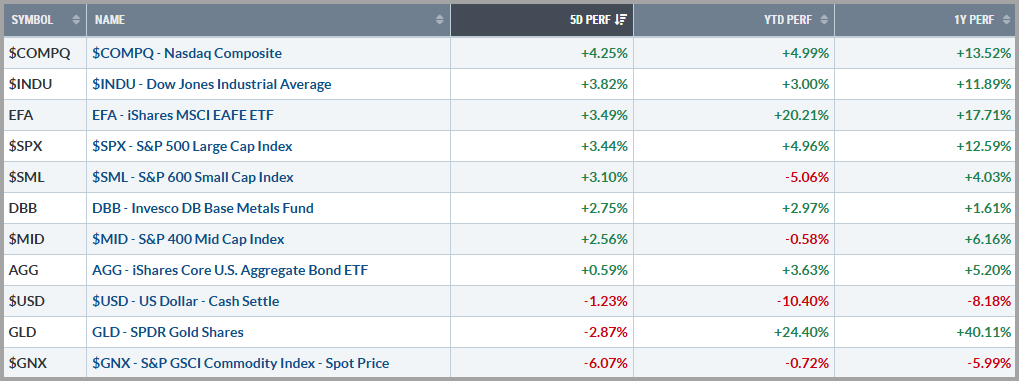Weekly Wrap: Records, Relief, and Rallying Tech
Stocks rallied to fresh all-time highs last week, seemingly driven by easing geopolitical tensions, stable economic data, and a slightly more dovish tone from the Federal Reserve. Equity markets surged by better than 3% on average for the week and are now sitting at, or close to, all-time highs once again.
Cooling risks in the Middle East helped calm markets, while better-than-expected economic reports may have helped ease recession concerns. At the same time, the Fed’s latest comments reassured investors that interest rate policy is likely to stay supportive.
Once again, enthusiasm around AI and strong performance from tech and tech-related sectors continued to reportedly drive the rally, playing a big role in the market’s relatively strong Q2 rebound.
Over in the commodities markets, gold cooled off last week after a notable run, as investors seemingly took profits amid the “fear trade” cooling off. Oil prices, which had spiked recently, dropped sharply as tensions in the Middle East eased, while copper and other industrial metals went up, reportedly driven by easing tariff concerns and possible supply issues.
The U.S. dollar also weakened, hitting a three-year low, likely due to falling oil prices inflation implications and signs that the Federal Reserve might be less aggressive with interest rates. In the bond market, interest rates on 10-year Treasury notes continued to fall as inflation worries eased and the Fed struck a more reassuring tone.
All in all, the combination of calming global tensions, steady economic data, and renewed AI enthusiasm improved sentiment and helped push stocks to new highs.

Source: stockcharts.com
Looking Ahead: A Short Week, But a Big One
This holiday-shortened week has the potential to pack a big punch, with three major economic reports on deck that could shape the market’s next move. All this being delivered while many will be on vacation (which typically leads to light volumes) could introduce some volatility.
The most important release is Thursday’s jobs report. Recent labor market data has shown signs of slowing, and if job growth comes in weak, that may weigh on investor sentiment. We’ll also get updates on the health of the manufacturing and services sectors, with the ISM Manufacturing PMI on Tuesday and the ISM Services PMI on Thursday. Last month, both fell below 50, signaling contraction. One month of weak numbers isn’t too alarming, but if we see a second straight month below 50, it becomes more of a red flag. Ideally, we want to see at least one of these reports bounce back above 50 to ease slowdown worries.
Weak data across any of these reports could likely hit investor sentiment and reintroduce recession fears, however, it may also strengthen conviction surrounding near-term Fed rate cuts with the opposite effect on strong data — how the markets will react is anyone’s guess at this juncture and will be worthy of close attention.
Bottom line: Despite the holiday, this is a critical week for economic data. With equity markets back near historically high valuations and forming a potential double-top pattern (potential resistance) on the charts, what looks like calm could quickly turn into concern. We’ll be watching closely and will continue to keep you informed of any key shifts right here in your weekly newsletter.
Tying it all together:
Markets are currently walking a fine line. The economic data we’ve seen lately paints a picture of a soft but steady environment as growth is slowing, but potentially not enough to spark recession fears. At the same time, it’s not strong enough to take rate cuts off the table. The Federal Reserve has left interest rates unchanged, but recent comments from officials suggest they remain open to easing policy later this year, especially if inflation continues to trend lower. That outlook has seemingly helped support equity markets, which currently remain near multi-month highs.
The labor market continues to be a relatively bright spot. While job growth has cooled somewhat from last year’s pace, unemployment remains low, and wage pressures have moderated without falling off a cliff. This “not too hot, not too cold” dynamic is giving the Fed more flexibility with enough economic strength to avoid a downturn, but not so much that it risks reigniting inflation. Still, the Fed is walking a narrow path, and any surprises in inflation or employment data could shift the outlook quickly.
At the same time, stock market valuations remain elevated, reflecting a high level of investor confidence, or perhaps complacency. Despite ongoing geopolitical risks, tariff and trade war concerns, and an uncertain Fed timeline, sentiment remains relatively optimistic. The market seems to currently be pricing in a near-perfect scenario where inflation continues to fall, the labor market remains strong, the Fed starts cutting rates, and the economy avoids a recession. While that outcome is possible, it leaves little room for error.
Looking ahead, we see both risks and opportunities. On the one hand, volatility could pick up if the current narrative begins to change. On the other hand, a stable labor market and easing inflation pressures could create a supportive environment for well-positioned portfolios. In this kind of landscape, staying diversified, focusing on quality, and remaining flexible and adaptive as the backdrop emerges has consistently served investors well.
Please feel free to share these commentaries and, should you have any questions regarding your current strategy or the markets in general, please reach out to your CIAS Investment Adviser Representative.
Important Disclosures:
Past performance is not indicative of future results. This material is not financial advice or an offer to sell any product. The statements contained herein are solely based upon the opinions of Edward J. Sabo and the data available at the time of publication of this report, and there is no assurance that any predicted or implied results will actually occur. Information was obtained from third-party sources, which are believed to be reliable, but are not guaranteed as to their accuracy or completeness.
The actual characteristics with respect to any particular client account will vary based on a number of factors including but not limited to: (i) the size of the account; (ii) investment restrictions applicable to the account, if any; and (iii) market exigencies at the time of investment. Capital Investment Advisory Services, LLC (CIAS) reserves the right to modify its current investment strategies and techniques based on changing market dynamics or client needs. The information provided in this report should not be considered a recommendation to purchase or sell any particular security. There is no assurance that any securities discussed herein will remain in an account’s portfolio at the time you receive this report or that securities sold have not been repurchased. The securities discussed may not represent an account’s entire portfolio and in the aggregate may represent only a small percentage of an account’s portfolio holdings. It should not be assumed that any of the securities transactions, holdings or sectors discussed were or will prove to be profitable, or that the investment recommendations or decisions we make in the future will be profitable or will equal the investment performance of the securities discussed herein.
CIAS is a registered investment advisor. More information about the advisor, including its investment strategies and objectives, can be obtained by visiting www.capital-invest.com. A copy of CIAS’s disclosure statement (Part 2 of Form ADV) is available, without charge, upon request. Our Form ADV contains information regarding our Firm’s business practices and the backgrounds of our key personnel. Please contact us at (919) 831-2370 if you would like to receive this information.
Capital Investment Advisory Services, LLC
100 E. Six Forks Road, Ste. 200; Raleigh, North Carolina 27609
Securities offered through Capital Investment Group, Inc. & Capital Investment Brokerage, Inc.

